-
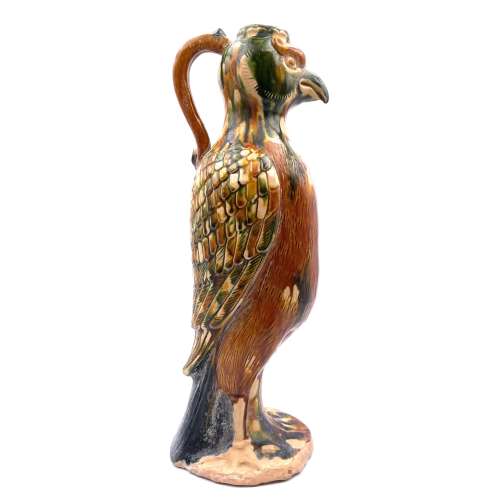 Made of two moulded symmetrical halves, joined before attaching the handle. On an unglazed base. Glazed in three colours (green, amber and ivory) and the tail is glazed black or dark blue. China, the Tang dynasty [唐朝] (618 – 907). Height: 37 cm.
Made of two moulded symmetrical halves, joined before attaching the handle. On an unglazed base. Glazed in three colours (green, amber and ivory) and the tail is glazed black or dark blue. China, the Tang dynasty [唐朝] (618 – 907). Height: 37 cm. -
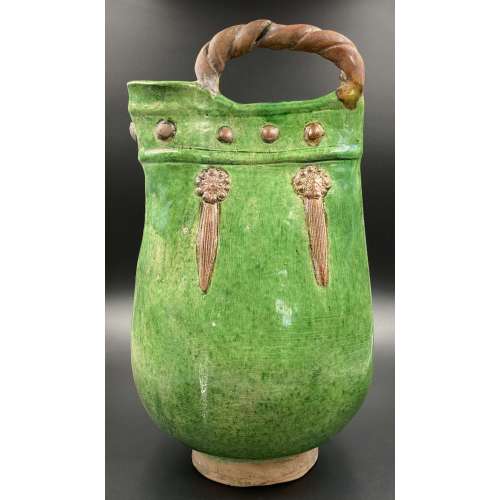 Footed purse-like ewer with twisted handle, with sculptured body glazed in green and details glazed in brown, on an unglazed foot. China, the Liao Dynasty [辽朝] (907 – 1125). Dimensions: 29 x 15 x 15 cm
Footed purse-like ewer with twisted handle, with sculptured body glazed in green and details glazed in brown, on an unglazed foot. China, the Liao Dynasty [辽朝] (907 – 1125). Dimensions: 29 x 15 x 15 cm -
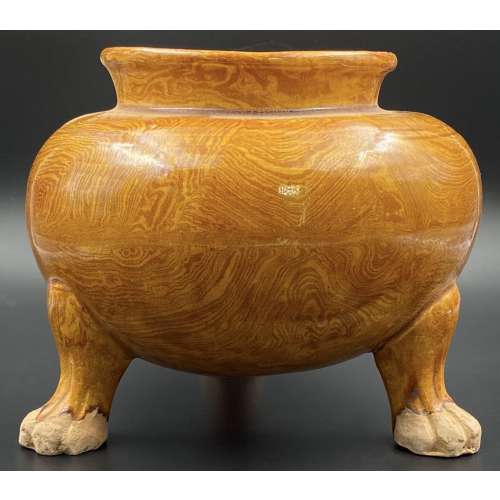 Amber-glazed marbled pottery tripod censer, standing on unglazed beast's paws. The clay itself is not marbled, only the glaze. China, the Tang dynasty [唐朝] (618 – 907). Diameter: 16 cm; Height: 14 cm.
Amber-glazed marbled pottery tripod censer, standing on unglazed beast's paws. The clay itself is not marbled, only the glaze. China, the Tang dynasty [唐朝] (618 – 907). Diameter: 16 cm; Height: 14 cm. -
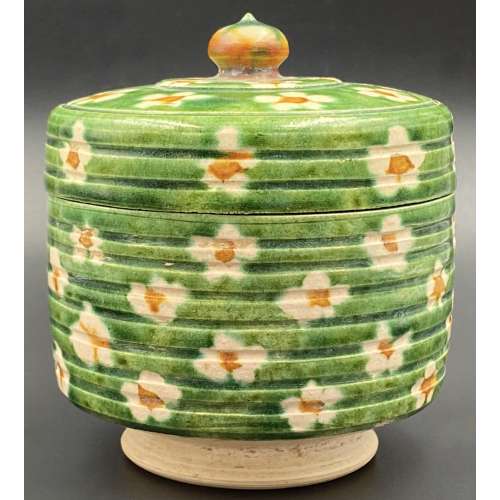 Green, mottled (white, yellow, brown) glazed earthenware jar or a circular box with a cover, on an unglazed foot decorated with florets. The cover has a small knop. Ivory glaze inside. China, the Tang dynasty [唐朝] (618 – 907). Diameter: 10 cm; Height: 10 cm.
Green, mottled (white, yellow, brown) glazed earthenware jar or a circular box with a cover, on an unglazed foot decorated with florets. The cover has a small knop. Ivory glaze inside. China, the Tang dynasty [唐朝] (618 – 907). Diameter: 10 cm; Height: 10 cm. -
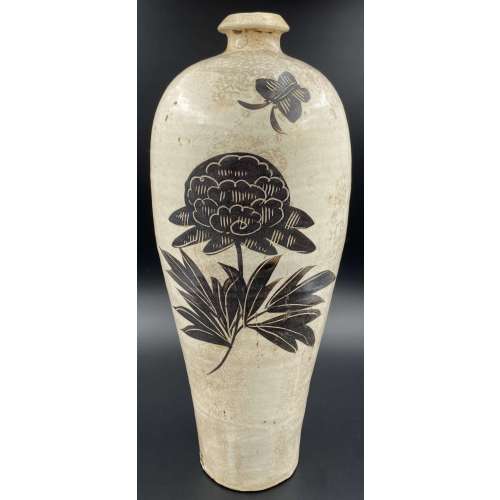 Typical meiping body, short neck, lipped rim; painted in the blackish-brown slip with two blossoms and butterflies under a clear glaze. The foot ring is unglazed exposing the brown body. China, the Yuan Dynasty [大元] (1279 – 1368). Diameter: 14 cm; Height: 30.5 cm.
Typical meiping body, short neck, lipped rim; painted in the blackish-brown slip with two blossoms and butterflies under a clear glaze. The foot ring is unglazed exposing the brown body. China, the Yuan Dynasty [大元] (1279 – 1368). Diameter: 14 cm; Height: 30.5 cm. -
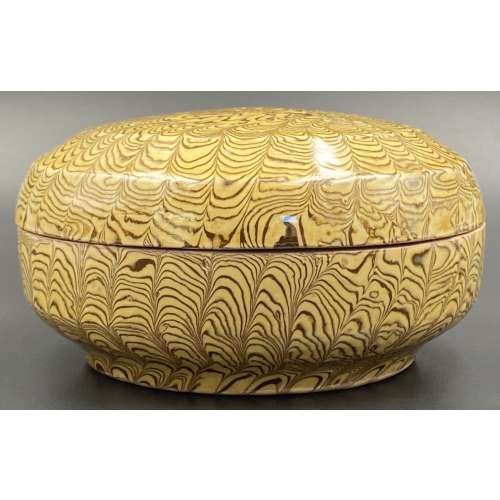 Press moulded round box with a cover made of yellow and brown marble clay, glazed with a clear glaze inside and outside. China, the Tang dynasty [唐朝] (618 – 907) Diameter: 11 cm; Height: 5.5 cm.
Press moulded round box with a cover made of yellow and brown marble clay, glazed with a clear glaze inside and outside. China, the Tang dynasty [唐朝] (618 – 907) Diameter: 11 cm; Height: 5.5 cm. -
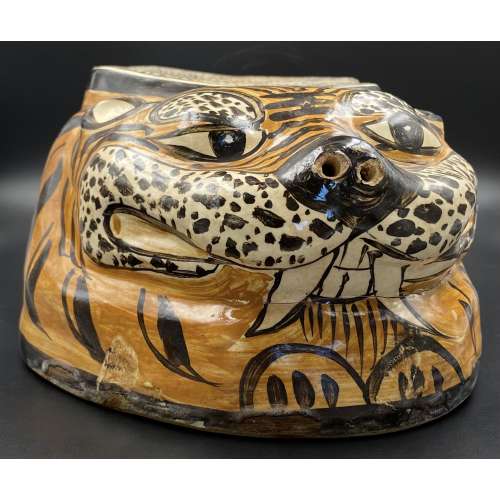 The pillow is moulded as a recumbent tiger, the details painted in dark brown and pale russet on a white slip and under a clear glaze, and the slightly dished top is painted with a winged beast. China, the Jin dynasty [金朝] (1115 – 1234). Dimensions: 12 x 34.5 x 19.5 cm
The pillow is moulded as a recumbent tiger, the details painted in dark brown and pale russet on a white slip and under a clear glaze, and the slightly dished top is painted with a winged beast. China, the Jin dynasty [金朝] (1115 – 1234). Dimensions: 12 x 34.5 x 19.5 cm -
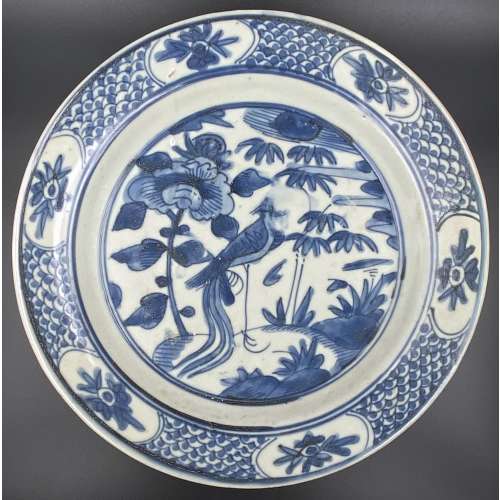 Underglaze cobalt blue and white Zhangzhou (Swatow) porcelain plate decorated vigorously and spontaneously with a bird in the landscape, and flowers in oval cartouches among waves or fish scale diaper. Sand particles on the base. Ming Dynasty [大明] (1368 – 1644); Wanli Era (1572 – 1620); Late 16th – Early 17th century. Diameter: 28.2 cm; Height: 4.0 cm
Underglaze cobalt blue and white Zhangzhou (Swatow) porcelain plate decorated vigorously and spontaneously with a bird in the landscape, and flowers in oval cartouches among waves or fish scale diaper. Sand particles on the base. Ming Dynasty [大明] (1368 – 1644); Wanli Era (1572 – 1620); Late 16th – Early 17th century. Diameter: 28.2 cm; Height: 4.0 cm -
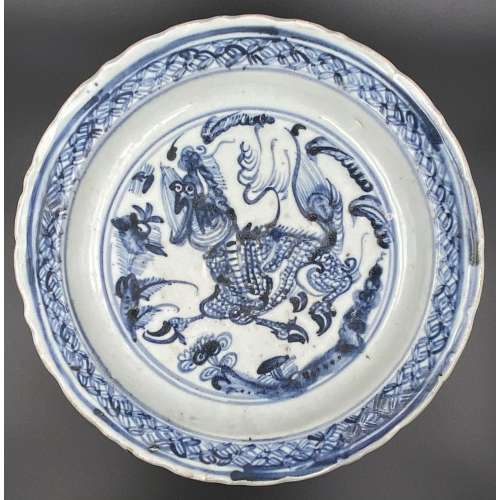 Footed plate with scalloped rim, centre decorated with running yak or another even-toed animal among flowers, jewel diaper pattern to the inner lip; foliage motif to the outside is bordered with foliage above and lotus leaves below. Porcelain with underglaze blue decoration. Ming Dynasty [大明] (1368 – 1644); Wanli Era (1572 – 1620); Late 16th – Early 17th century. Diameter: 25.5 cm; Height: 4.2 cm
Footed plate with scalloped rim, centre decorated with running yak or another even-toed animal among flowers, jewel diaper pattern to the inner lip; foliage motif to the outside is bordered with foliage above and lotus leaves below. Porcelain with underglaze blue decoration. Ming Dynasty [大明] (1368 – 1644); Wanli Era (1572 – 1620); Late 16th – Early 17th century. Diameter: 25.5 cm; Height: 4.2 cm -
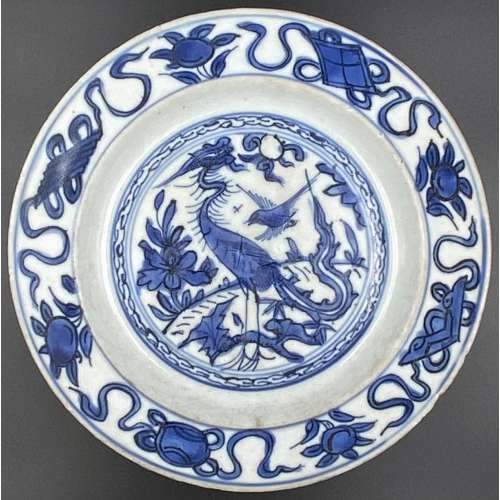 Plate with crane, bird, plants, and four treasures. Porcelain with underglaze blue decoration and illegible factory mark to the bottom. Ming Dynasty [大明] (1368 – 1644); Wanli Era (1572 – 1620); Late 16th – Early 17th century. Diameter: 19.5 cm; Height: 3 cm
Plate with crane, bird, plants, and four treasures. Porcelain with underglaze blue decoration and illegible factory mark to the bottom. Ming Dynasty [大明] (1368 – 1644); Wanli Era (1572 – 1620); Late 16th – Early 17th century. Diameter: 19.5 cm; Height: 3 cm -
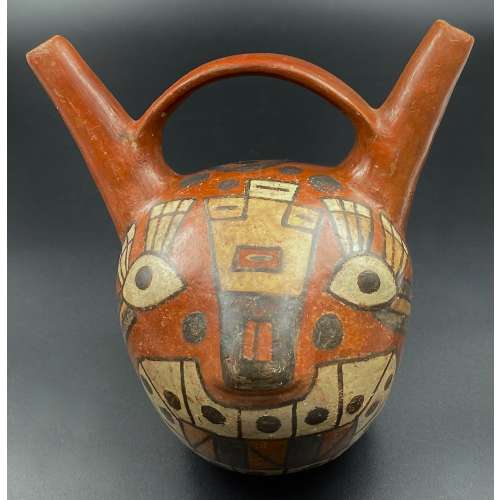 Pre-Columbian, Peru, Wari (Huari) culture, ca. 650 to 1000 CE.
Pre-Columbian, Peru, Wari (Huari) culture, ca. 650 to 1000 CE.A hand-built polychrome ceramic stirrup vessel depicting the head of a jaguar. Painted with a sienna-hued base, this spotted beast features an abstract visage of almond-shaped eyes opened wide with long feather-like lashes, a rectangular nose protruding from a nasal bridge decorated with a quadrilateral motif, and a large open mouth, showing both upper and lower teeth, which are also spotted, all painted in shades of cream, black, cream, grey, light grey, and beige. Highly burnished, the lustrous vessel exhibits two spouts, also functioning as ears of the jaguar, with a flat handle arching between them. This tool would have been a grave good intended to hold some kind of libation or offering and was likely made in a specialist workshop.
Colours: Sienna (base), black, cream, grey, light grey, beige (7 colours).
Dimension: Width (mouth-to-mouth): 15 cm; Height: 14.5 cm; Diameter of the body: 10.5 cm. Provenance: Hans Juergen Westermann collection, Germany. The Wari State was the first expansionistic power to develop in the Andean highlands. It was located in Vilcabamba, modern Espiritu Pampa (Plain of the Spirits), Echarate District of La Convención Province in the Cuzco Region of Peru. The Wari expanded around AD 650 and by the time of their collapse in AD 1000 they controlled much of the central Andes. -
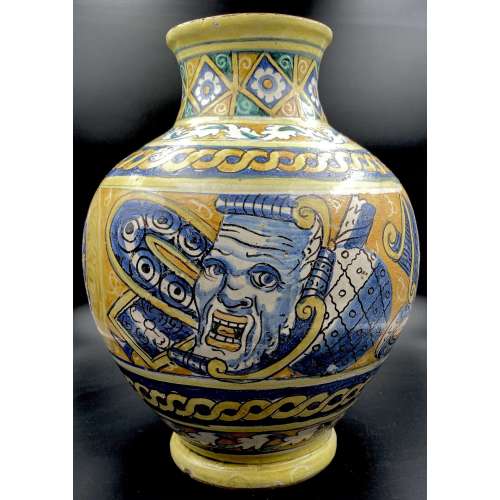
-
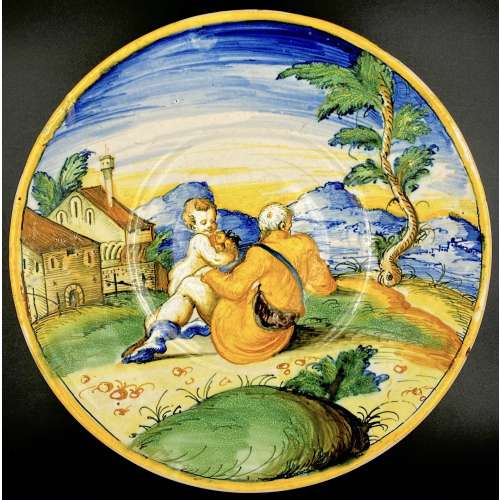
-
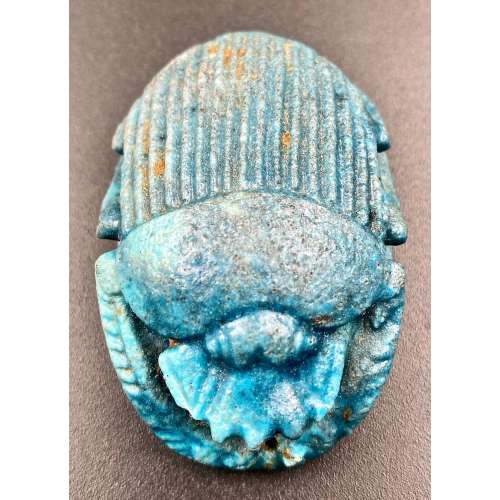 Egypt, Late Period. The oval amulet with multiple pierced holes for stitching to the outer garments of a mummy or the mummy wrappings, reeded wings and braided claws, marine blue in colour. According to the Brooklyn Museum, such faience amulets formed part of the beadwork pattern and served to protect the mummy through their magical properties. It served as a substitute heart that would ensure continued existence in the hereafter. A similar example at the Brooklyn Museum dated ca. 712-342 BC. Dimensions: 55 x 37 mm Provenance: The Collection of Erwin Harvith (1918 – 2011) and Sylvia Redblatt Harvith (1920 – 2015), Detroit, MI, acquired in 1972 directly from the Collection of Moshe Dayan, (משה דיין; 1915 – 1981), an Israeli military leader and politician. Exhibited: Jewish Museum, New York, NY, "Culture and Continuity – The Jewish Journey", 1975.
Egypt, Late Period. The oval amulet with multiple pierced holes for stitching to the outer garments of a mummy or the mummy wrappings, reeded wings and braided claws, marine blue in colour. According to the Brooklyn Museum, such faience amulets formed part of the beadwork pattern and served to protect the mummy through their magical properties. It served as a substitute heart that would ensure continued existence in the hereafter. A similar example at the Brooklyn Museum dated ca. 712-342 BC. Dimensions: 55 x 37 mm Provenance: The Collection of Erwin Harvith (1918 – 2011) and Sylvia Redblatt Harvith (1920 – 2015), Detroit, MI, acquired in 1972 directly from the Collection of Moshe Dayan, (משה דיין; 1915 – 1981), an Israeli military leader and politician. Exhibited: Jewish Museum, New York, NY, "Culture and Continuity – The Jewish Journey", 1975. -
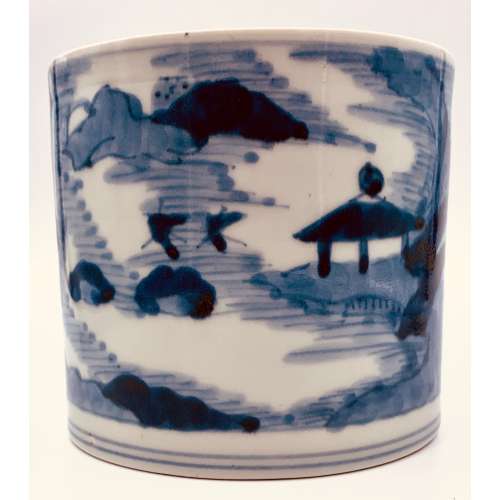
-
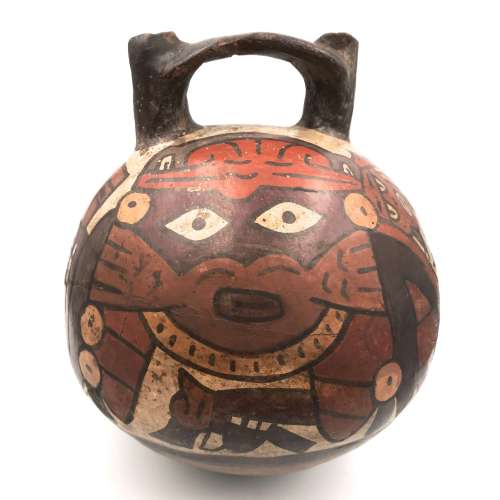
Pre-Columbian, South Coast of Peru, Nazca, ca.200 - 500 CE. Polychrome double-spout, or stir-up vessel (jar, or bottle), decorated on both sides with designs of anthropomorphic Mythical Spotted Cat (or the Cat Deity) with hand holding the club, a trophy head and spears.
Colors: Black, Cream, Gray, Orange, White, Dark Red (7 colors).
Size: Diameter 15.2 cm. References:- A Sourcebook of Nasca Ceramic Iconography: Reading a Culture through Its Art. Donald A. Proulx. University of Iowa Press, 2006; pp. 88-91. [LIB-1556].
- The Archaeology and Pottery of Nazca, Peru: Alfred Kroeber’s 1926 Expedition. Alfred L. Kroeber and Donald Collier, edited by Patrick H. Carmichael with an afterword by Katharina J. Schreiber. AltaMira Press in coop. with Field Museum, Chicago, Il., 1998; p.121. [LIB-1557].
-
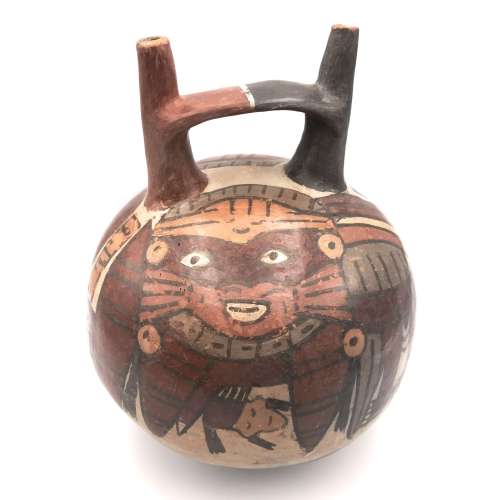
Pre-Columbian, South Coast of Peru, Nazca, ca. 400 - 600 CE. Polychrome double-spout, or stir-up vessel (jar, or bottle), decorated on both sides with designs of masked Mythical Spotted Cat (or the Cat Deity) with a trophy head. Colors: Black, Cream, Gray, Orange, White, Dark Red, Light Red (8 colors).
Size: 17.2 x 14 cm.
References:- A Sourcebook of Nasca Ceramic Iconography: Reading a Culture through Its Art. Donald A. Proulx. University of Iowa Press, 2006; pp. 88-91. [LIB-1556].
- The Archaeology and Pottery of Nazca, Peru: Alfred Kroeber’s 1926 Expedition. Alfred L. Kroeber and Donald Collier, edited by Patrick H. Carmichael with an afterword by Katharina J. Schreiber. AltaMira Press in coop. with Field Museum, Chicago, Il., 1998; p.121. [LIB-1557].
Ex Arte Xibalba, Florida; Ex Robert Dowling Gallery, San Francisco, CA.
-
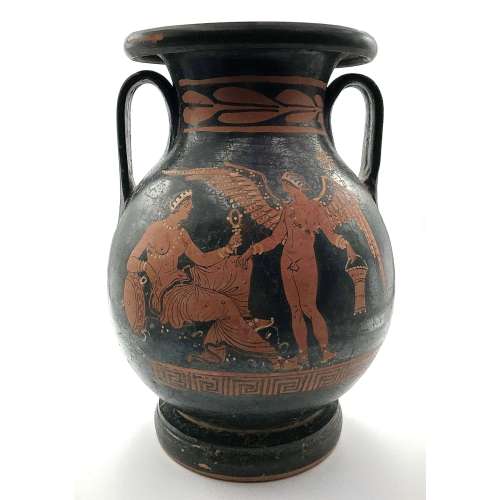 Seller provided description:"Finely painted via the red-figure technique, an elegant pelike vessel of a classic globular form with a cylindrical neck rising to a flared rim, and twin fluted handles, all upon a raised, concave, disc foot.Side A depicts a winged Eros who stands in contrapposto facing toward the left, in the nude save sandals, bracelets, a beaded sash, and a stephane (wreath) holding a situla (pail) in his left hand and gesturing toward the seated maenad before him. Though with her breasts exposed, the maenad does wear a lower garment, and is bedecked with a stephane, multiple bracelets, and strands of pearls around her neck - all delineated in fugitive white and yellow pigment. She holds a mirror in her left upraised hand and leans upon a tambourine with her right elbow. Above and to the right is a maker's mark of a circular format with a central X that is further adorned by nested wedges and dot motifs. Side B presents two opposing standing draped male figures, the gent on the left leaning upon a walking stick. Complementing the figural program, is a lovely decorative program adorning both sides of the vessel, with bands of laurel leaves above and a repeating Greek key/meander below. An outstanding example, masterfully wheel thrown, so that we see absolutely no signs of any jogs in the transitions between the different elements of the vase. Moreover, it presents ideal proportions perfect for presenting the superb painted iconographic/decorative program. The painting was executed with the utmost skill and artistry - the red-figure technique enabling the artist to delineate the figures' musculature, facial details, as well as the cascading drapery folds with extensive fugitive paint embellishments.Expected surface wear with some scuffs and pigment losses commensurate with age, but the painted program is generally very well preserved. Area of repair/restoration to cloak of male on right (Side B). Minute nick to left of male on left (Side B). Nice root marks throughout and areas of encrustation. Thermoluminescence (TL) report: the piece has been found to be ancient and of the period stated. Equivalent age: 2400 +/- 300 years. Certificate of Authenticity from Artemis Gallery. Provenance: private East Coast, USA collection. Greece, Southern Italy, Apulia, ca. 330 BCE.Size: 6.75" in diameter x 9.875" H (17.1 cm x 25.1 cm)Polina de Mauny, being both attentive and knowledgeable, was the first who noticed a possible mistake in the description above. It is highly probable that the woman on side A is not a maenad but Aphrodite herself, holding a mirror and leaning on a shield. Maenads were "often portrayed as inspired by Dionysus into a state of ecstatic frenzy through a combination of dancing and intoxication". The situla, held by Eros, unequivocally alludes to Dionysian ritual, which has to do as much with maenads as with Aphrodite. The nature of two men on side B remain unclear.
Seller provided description:"Finely painted via the red-figure technique, an elegant pelike vessel of a classic globular form with a cylindrical neck rising to a flared rim, and twin fluted handles, all upon a raised, concave, disc foot.Side A depicts a winged Eros who stands in contrapposto facing toward the left, in the nude save sandals, bracelets, a beaded sash, and a stephane (wreath) holding a situla (pail) in his left hand and gesturing toward the seated maenad before him. Though with her breasts exposed, the maenad does wear a lower garment, and is bedecked with a stephane, multiple bracelets, and strands of pearls around her neck - all delineated in fugitive white and yellow pigment. She holds a mirror in her left upraised hand and leans upon a tambourine with her right elbow. Above and to the right is a maker's mark of a circular format with a central X that is further adorned by nested wedges and dot motifs. Side B presents two opposing standing draped male figures, the gent on the left leaning upon a walking stick. Complementing the figural program, is a lovely decorative program adorning both sides of the vessel, with bands of laurel leaves above and a repeating Greek key/meander below. An outstanding example, masterfully wheel thrown, so that we see absolutely no signs of any jogs in the transitions between the different elements of the vase. Moreover, it presents ideal proportions perfect for presenting the superb painted iconographic/decorative program. The painting was executed with the utmost skill and artistry - the red-figure technique enabling the artist to delineate the figures' musculature, facial details, as well as the cascading drapery folds with extensive fugitive paint embellishments.Expected surface wear with some scuffs and pigment losses commensurate with age, but the painted program is generally very well preserved. Area of repair/restoration to cloak of male on right (Side B). Minute nick to left of male on left (Side B). Nice root marks throughout and areas of encrustation. Thermoluminescence (TL) report: the piece has been found to be ancient and of the period stated. Equivalent age: 2400 +/- 300 years. Certificate of Authenticity from Artemis Gallery. Provenance: private East Coast, USA collection. Greece, Southern Italy, Apulia, ca. 330 BCE.Size: 6.75" in diameter x 9.875" H (17.1 cm x 25.1 cm)Polina de Mauny, being both attentive and knowledgeable, was the first who noticed a possible mistake in the description above. It is highly probable that the woman on side A is not a maenad but Aphrodite herself, holding a mirror and leaning on a shield. Maenads were "often portrayed as inspired by Dionysus into a state of ecstatic frenzy through a combination of dancing and intoxication". The situla, held by Eros, unequivocally alludes to Dionysian ritual, which has to do as much with maenads as with Aphrodite. The nature of two men on side B remain unclear.


